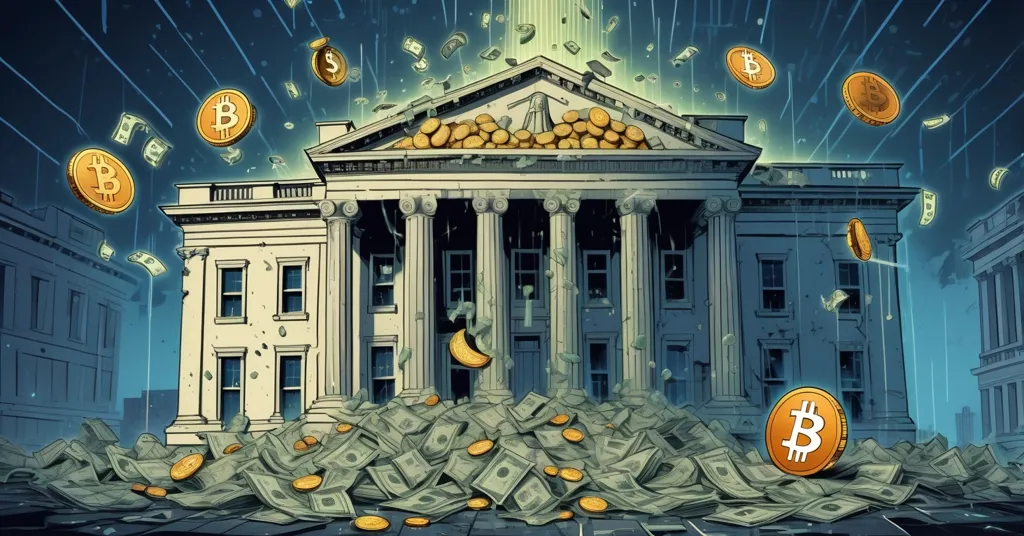Trump Allies Target Fed’s $2.5B Renovation: Oversight or Attack on Powell?

Trump Allies Push for Probe into Federal Reserve’s $2.5 Billion Renovation: Oversight or a Political Hit Job?
Trump allies are gunning for answers over the Federal Reserve’s jaw-dropping $2.5 billion headquarters renovation in Washington, D.C., a project that’s ballooned over 30% from its initial $1.9 billion estimate. Is this a legitimate call for accountability, or a thinly veiled attack on Fed Chairman Jerome Powell amid long-standing monetary policy clashes?
- Budget Blowout: Costs for the Fed’s historic buildings surged from $1.9B to $2.5B, raising red flags over potential mismanagement.
- Political Chess: Trump’s camp seems to be weaponizing the overrun to target Powell over interest rate disagreements.
- Crypto Connection: Centralized financial failures spotlight why Bitcoin and decentralized systems are gaining traction as alternatives.
The Fed’s $2.5B Debacle: Why the Massive Overrun?
The Federal Reserve’s headquarters, consisting of the Marriner S. Eccles Building (built in 1937) and the East Building (dating back to 1931), are nearly a century old and have never seen a full-scale renovation until now. Located in D.C.’s highly regulated “monumental core,” any work on these structures comes with a mountain of federal oversight, historic preservation rules, and strict safety standards introduced after major national security events like 9/11. Fed Chairman Jerome Powell has been clear about the need for this overhaul, bluntly stating to Congress that the Eccles Building was “not really safe” and “not waterproof.” In a letter dated July 17, 2025, to OMB Director Russell Vought, he reiterated that the project is transparent and essential for meeting modern safety, environmental, and accessibility demands—think sustainable green roofs to manage stormwater and updated elevators for better access.
“With independence comes the responsibility to provide transparency that enables effective oversight by Congress.” – Jerome Powell
But the numbers are hard to swallow. That $700 million overrun isn’t pocket change, even for a central bank. What drove it? A perfect storm of issues: steel prices spiked in 2021, unexpected site challenges like a higher-than-expected water table and toxic soil demanded costly fixes, and federal design reviews dragged on for years. One particularly grueling task involved lowering the Eccles Building’s foundation by over 20 feet using specialized supports drilled deep into the ground—think of them as underground stilts to stabilize shaky soil, a process detailed in recent updates on the underground construction challenges. Add to that the conversion of old parking garages into office space and a new underground 318-space garage, all constrained by D.C.’s strict height limits forcing much of the expansion below ground. It’s a technical nightmare, no doubt, but one that begs the question: couldn’t this level of inefficiency be avoided with better planning or, dare we say, a more transparent system?
Mina Wright from the General Services Administration’s Office of Planning and Design Quality summed up the gauntlet the Fed’s team faced in 2021:
“They’ve been really put through their paces… They’ve had some hostile criticism at one point that was unjustified.” – Mina Wright
Political Power Play: Is Powell the Real Target?
Beneath the surface of this budget brouhaha lies a deeper, uglier game. Donald Trump has never hidden his disdain for Powell, repeatedly slamming the Fed chairman for not slashing interest rates to juice the economy, especially during his pushes for aggressive tariffs and other policy moves. This isn’t new—Trump’s frustration dates back to his first term when rate hikes clashed with his growth agenda. Now, with allies seizing on the renovation costs as potential evidence of mismanagement or worse, the push for an investigation feels less like a quest for fiscal responsibility and more like a calculated strike to oust Powell, as explored in discussions about possible political motives behind the scrutiny. If successful, it could rattle the very foundation of the Fed’s independence, a principle meant to shield monetary policy from political whims. For those unfamiliar, this independence allows the Fed to make decisions like setting interest rates without direct government interference, a buffer now under serious threat.
Not everyone in the GOP is on board with this attack. Senators like John Kennedy and Thom Tillis have sounded alarms, warning that undermining the Fed’s autonomy could send shock waves through the economy. They point to examples like Turkey, where political meddling in central banking fueled inflation rates as high as 30% at one point. Tillis called any move to fire Powell a “colossal mistake,” and he’s not wrong—history shows that when politics poisons money supply decisions, fiat currencies often take a nosedive. Powell, meanwhile, isn’t backing down, requesting an Inspector General review to address concerns head-on. But for skeptics, especially in our crypto circles, this gesture might feel like a Band-Aid on a broken system. If centralized institutions are so vulnerable to political games, how can we trust them with something as critical as our money?
Centralized Chaos: Why Decentralization Looks Better Every Day
This whole fiasco is a glaring reminder of why centralized financial systems keep stumbling. The Federal Reserve wields immense power over the U.S. dollar—printing money, setting rates, influencing global markets—yet it’s caught in a quagmire of questionable spending and political crosshairs over a mere building renovation. Imagine if this $2.5 billion was tracked on a blockchain, every transaction immutable and visible to all. Would we even be debating fraud or mismanagement? Bitcoin offers exactly that—a trustless ledger where no single entity can manipulate the books behind closed doors. For us maximalists, this is the ultimate “I told you so” moment: central banks are legacy systems ripe for disruption, a perspective reinforced by analyses on Bitcoin as an alternative to centralized finance.
That said, let’s not pretend crypto is a flawless utopia. Decentralized systems have their own messes—think DAO hacks or Ethereum’s contentious forks when governance disagreements spiral. But even with those flaws, the accountability baked into public blockchains far outstrips the opaque bureaucracy of traditional finance. Altcoins and other protocols like Ethereum also play a vital role, filling gaps Bitcoin doesn’t address. Smart contracts, for instance, could theoretically manage public funds with automated transparency, cutting out the middlemen who balloon budgets in D.C. While Bitcoin remains the gold standard for sound money with its fixed supply, these innovations highlight a broader truth: decentralization offers tools to rethink how we handle everything from renovations to entire economies.
Stepping back, this controversy also fuels the case for Bitcoin as a hedge against fiat instability. If political interference in the Fed leads to rash monetary moves—say, forced rate cuts sparking inflation—your dollar’s value could erode overnight. Bitcoin, free from such meddling, becomes a safe haven for those of us wary of centralized overreach. Sure, it’s volatile, but at least its rules aren’t rewritten by the highest bidder in a political auction.
Systemic Failures: D.C.’s Money Pit Isn’t Just the Fed
Before we pile all the blame on the Fed, let’s zoom out. Cost overruns in Washington, D.C., are practically a tradition. The Smithsonian’s African American History Museum came in at $540 million, a whopping 50% over budget. The 9/11 Museum in New York hit $700 million after scaling back from a $1 billion plan. Even the Smithsonian Castle saw a proposed underground renovation scrapped when estimates reached $2 billion. Why the bloat? Federal projects in the capital face a gauntlet of regulations, security demands, and design disputes that turn budgets into fiction faster than you can say “government efficiency,” a topic dissected in discussions on why Fed renovation costs skyrocketed. The Fed’s $2.5 billion tab, while staggering, fits right into this pattern of systemic waste—a pattern that, for crypto advocates, screams for disruption.
These examples aren’t just trivia; they underscore a broader failure of centralized oversight. When every project drowns in red tape and political scrutiny, costs spiral beyond reason. Compare that to a decentralized model where funds could be allocated via transparent, community-vetted smart contracts. No design boards, no backroom deals—just code and consensus. It’s not a perfect fix, but it’s a damn sight better than watching billions vanish into D.C.’s black hole, as public sentiment reflects in forums like Reddit discussions on the Fed’s cost overruns.
Looking Ahead: Crypto’s Role in a Financial Reset
As this Fed drama unfolds, bigger questions loom. Central banks worldwide, including the Fed, are eyeing central bank digital currencies (CBDCs) as a modern counter to crypto’s rise. But are CBDCs a step toward embracing digital innovation, or just another way to tighten centralized control? For many of us in the crypto space, they’re the latter—a wolf in digital sheep’s clothing that could undermine the very freedom Bitcoin stands for. Meanwhile, the Fed’s literal crumbling walls highlight a deeper irony: while they spend billions on physical infrastructure, the real future of finance is being built in code, not concrete, a point underscored by ongoing criticism of Federal Reserve practices.
If the Fed can’t manage a renovation without scandal, should it be trusted to manage our money? This mess is a masterclass in why we need to accelerate the shift to decentralized alternatives. Bitcoin doesn’t need a headquarters, and it sure as hell doesn’t need $2.5 billion to stay relevant, a sentiment echoed in calls for investigations into the Fed’s massive renovation spending. Whether you’re a maxi or dabbling in altcoins, the takeaway is the same: centralized power is fragile, prone to manipulation, and overdue for a hard fork. Let’s keep pushing for a system where trust isn’t begged for—it’s coded in.
Key Questions and Takeaways
- What’s fueling the investigation into the Fed’s $2.5 billion renovation?
Trump allies are spearheading the probe, pointing to potential mismanagement, but it’s largely viewed as a political maneuver to undermine Jerome Powell over interest rate disputes. - Why did the renovation costs explode from the original estimate?
Costs jumped from $1.9 billion to $2.5 billion due to steel price surges, unexpected site issues like unstable soil and high water tables, and prolonged federal design reviews. - Does Powell’s justification for the project hold water?
He insists the overhaul is transparent and critical for safety and compliance, backed by a requested Inspector General review, though many question if the price tag is defensible for a central bank. - How does this mess bolster the case for Bitcoin and decentralization?
It exposes centralized finance’s flaws—political interference and murky spending—reinforcing the appeal of trustless systems like Bitcoin that operate beyond government reach. - Could blockchain tech prevent such financial scandals?
Absolutely. A public ledger for tracking funds would make every dollar traceable, slashing the odds of overruns or hidden agendas compared to the Fed’s opaque processes. - Is the Fed’s overrun an isolated issue, or part of a bigger problem?
It’s systemic. Other D.C. projects like the Smithsonian Museum show similar budget bloat, highlighting inefficiencies in centralized systems that crypto could disrupt.



